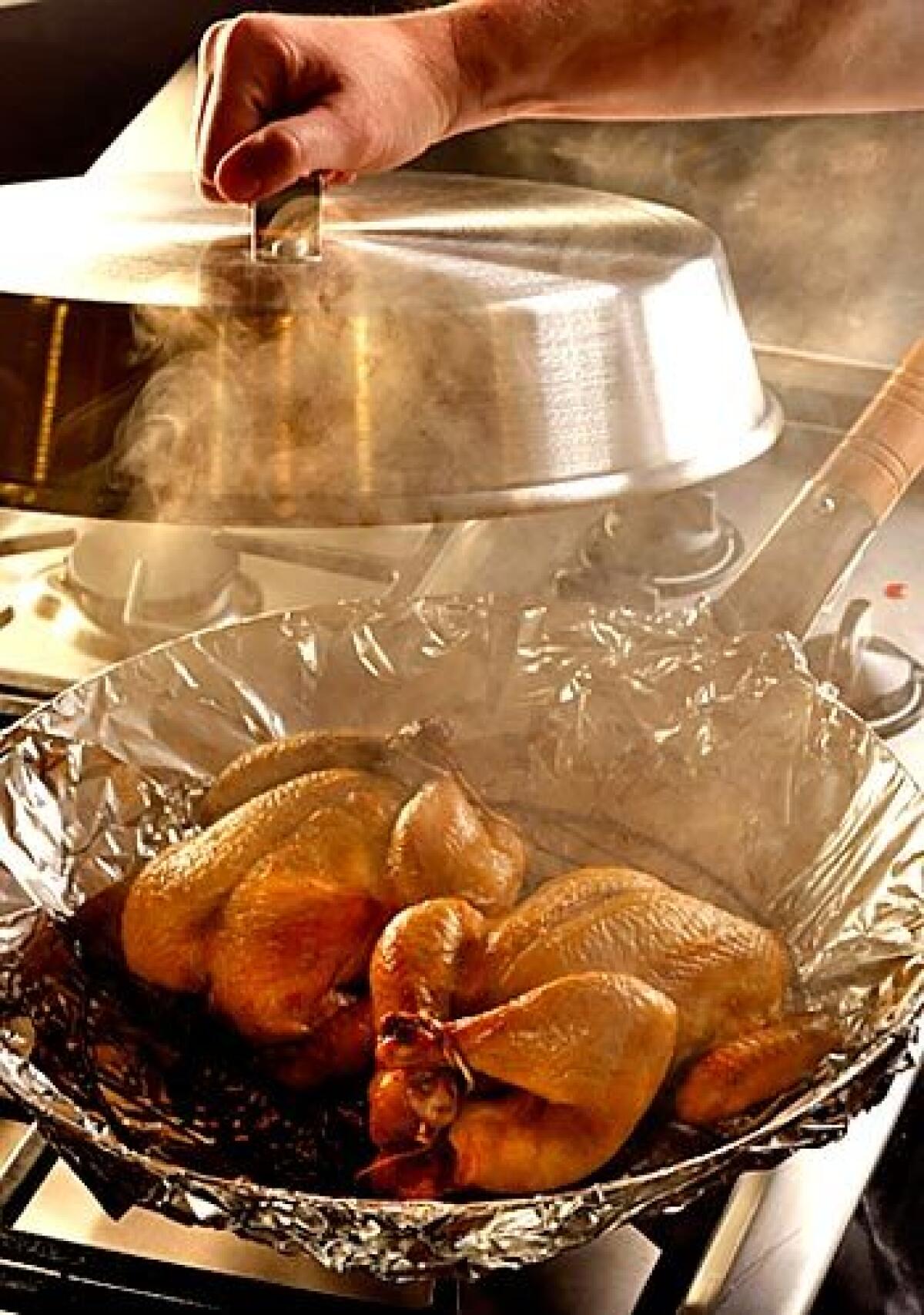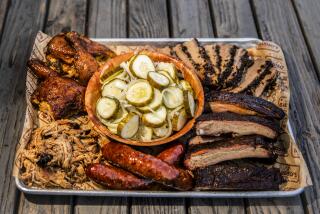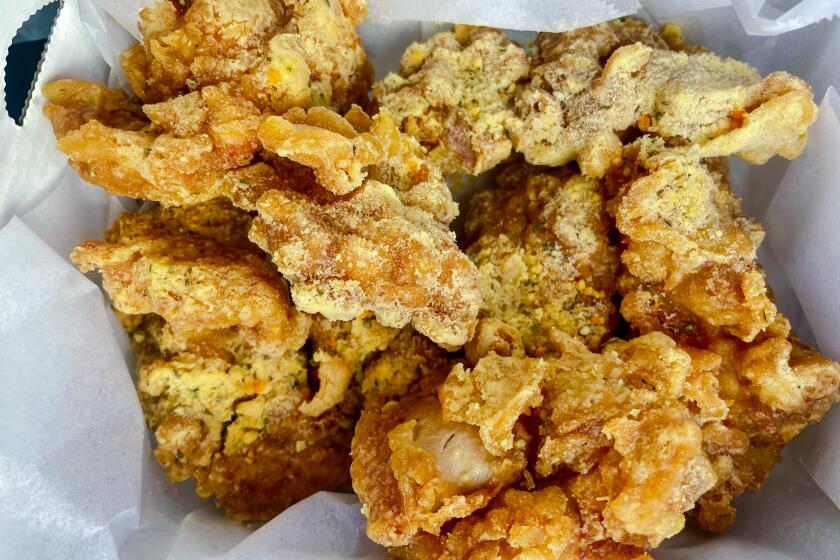Slow-smoking ribs in the great indoors

The other day, I just couldn’t shake the thought of slow-smoking some ribs. I was in the mood for Memphis-style baby backs, the meat fall-off-the-bone tender, a simple dry rub tantalizingly complicated with deep hickory notes, the flavors drawn out with a tart vinegar-Dijon mop.
There’s a primal wonder to smoked food — that such depth of flavor can come from so simple a technique. And then, of course, there’s the lure of the sunny afternoon spent in a lawn chair with a cold beer while you’re waiting, patiently, for the Weber to work its magic.
But then it started raining.
The audacity of winter. Even in Southern California, we have our seasons. I took a good long look at my kettle grill through the kitchen window as it rained, but those ribs wouldn’t stop dancing through my head, like a song that just wouldn’t let go.
Of course, not all smoking needs to be done outdoors, and I was not going to let the weather get in my way. Before long I was rummaging through the cupboard, looking for my large roasting pan. I grabbed a cooling rack, some heavy foil and a baking tin for a makeshift drip container and soon I was ready to smoke. Right in the kitchen. Right on the stove top. Rain or no rain.
Stove-top smoking is certainly not a new concept: Scatter some wood chips in a roasting pan, put the meat on a rack to sit above it. Loosely cover the pan and heat. Watch for the chips to start smoking and cover tight, then smoke to desired doneness. Voila.
There’s nothing complicated about stove-top smoking and I’d even argue that it’s probably easier to master than smoking outdoors. You don’t have to mess with charcoal or vents, deal with chambers or manage chips or pellets for hours on end.
On the stove top, you regulate the heat by adjusting the burner knob. It’s easy to set up (make a smoker from kitchen odds and ends as I did, or buy a commercially made one). And though you’ll smell the aroma of the smoke, most of it should be contained within the pan (you may get a faint whisp, but nothing to set off the fire alarm).
But like everything, stove-top smoking does have its limitations. First is size: Since the smokers have to be small enough to fit on the stove, you may not have the surface area you get with a regular smoker or grill.
Further, because the smoke is tightly contained, stove-top smokers can impart flavor quickly, so you’ll need to keep a careful eye on them to make sure food doesn’t come out smelling like a campfire.
And, of course, you may miss the glory of the great outdoors, getting a sunburn as you wait for that brisket to finish.
I cleaned my rack of baby backs and massaged a dry rub into the meat. I then refrigerated them, uncovered, overnight to form a pellicle (that tacky surface you want so the smoke — which is particulate — will adhere).
The next day I gently smoked them using no more than a few tablespoons of fine hickory chips smoldering over moderately low heat. After an hour the ribs were nicely smoked, the meat mostly done. I moved the rack to a baking dish and poured over a little of my “mop,” covered the dish tightly and continued to steam the ribs in a low oven until tender (I knew they were done when the meat tore easily from the bone).
To finish the ribs, I uncovered the dish and broiled them for just a couple of minutes to crisp the edges. I had my smoked ribs — almost as rich and flavorful as anything I could’ve smoked outdoors.
It’s amazing the depth of flavor just a little smoke can impart to a dish. But there’s more to it than mere “smokiness.” You’ll find a great variety of character, depending on the type of wood used and its intensity.
Woods range from assertive hickory to delicate apple. Cherry is pronounced and pecan lends a fragrant nuttiness. Mesquite can be either delicately sweet or overwhelmingly assertive depending on how (and how much) it is used. It’s not hard to find alder chips (popular in the Northwest) or corncob (possibly best known in the Northeast). Or try flavored hardwoods — say, wine casks or bourbon-soaked oak.
For stove-top smoking, look for small chips or shavings; they smolder more readily than larger chips.
Experiment with different woods, and when you’re comfortable, try blending. Like spice blends, smoker blends can impart distinct, layered flavors and lend amazing depth to a dish, whether you’re smoking a tough cut of meat or delicate fish or vegetables.
Try adding aromatics to the blend, such as herbs, spices or citrus peel. I recently smoked beef short ribs using a blend of hickory and oak chips to which I added fresh minced rosemary. I smoked the ribs for an hour to flavor, then finished them in the oven, braising them with garlic and red wine. The result was a richly complex dish, full of depth and flavor.
You can even smoke without any wood at all. I’ve tried riffing on classic tea-smoked duck with other birds and seasoning blends. I love game hens for their great flavor — and they’re small enough to make perfect single servings. Dry-brine the hens with a little five-spice powder, brown sugar, fresh grated orange peel, ginger and garlic. Roast them until they’re almost done, and then smoke the birds over very high heat using a wok (some pans and commercial stove-top smokers may not be suitable for smoking over high heat) for just a few minutes (too much smoke, and all that flavor turns to bitterness).
I’ve tried a variety of teas, including Lapsang souchong, which can be harshly intense as a tea but smokes beautifully. I’ve also tried tea-smoking combining the leaves with a blend of rice and sugar; the rice lends a wonderful earthy nuttiness to the flavor, and the sugar lends a sweet caramel finish and rich color to the dish. Out of curiosity, I tried smoking with fragrant jasmine tea — the flavor is amazingly delicate and sweet, subtle and flirtatiously aromatic.
Stove-top smokers are, by design, “hot” smokers, meaning they smoke and cook over higher heat; “cold” smokers, on the other hand, transmit smoke from one chamber to another over a distance, so that the meat is smoking but not cooking (cold smoking is a classic preservation technique).
With the stove-top smoker, I found that I was able to regulate the temperature fairly easily, heating just enough to smolder the wood chips while maintaining a low (225- to 250-degree) temperature. (I started at a moderate heat, then reduced the heat when the chips began smoking.) Inserting a probe thermometer makes it easy to check and adjust the burner as needed.
That control makes it a breeze to smoke even the most delicate items, such as shrimp, salmon and even oysters on the stove top. Recently, I tried scallops. I seasoned them with just a touch of salt and pepper and smoked them over a couple of teaspoons of alder chips until they were just barely opaque and cooked through, less than 15 minutes. To complement the smoky flavor and brighten the dish, I served the scallops over a tart fennel salad, dressed with a little olive oil, shallot and lemon juice. Simple flavors but a rich composition.
Of everything I’ve smoked, though, probably my favorite is pork belly. Marinate the meat in a simple brine with maple syrup and a little bourbon for a few days in the fridge. Then gently smoke the pork belly over apple wood for about an hour, until it is tender and the smoke has had a chance to infuse its flavor. Slice and serve it right away (it’s basically hot-smoked bacon), or add it to stews, hash or eggs.
And you can’t beat that aroma — there’s nothing like the smell of apple-wood-smoked bacon perfuming the house. As it smokes, I can’t help but reach into the fridge for a cold beer. Now if only I could fit a lawn chair in my kitchen.
More to Read
Eat your way across L.A.
Get our weekly Tasting Notes newsletter for reviews, news and more.
You may occasionally receive promotional content from the Los Angeles Times.










